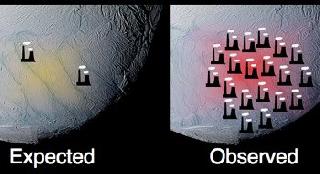
The graphic shows how the south polar terrain of Saturn's moon Enceladus emits much more power than scientists had originally predicted. A NASA/JPL photo
PASADENA (BNS): The south polar region of Saturn’s moon Enceladus has turned out to be a more ‘powerful heat house’ than previously thought.
The region, which features the well-known “tiger stripes” – four roughly parallel linear trenches that make the south pole geologically active – has been emanating heat much higher than was previously thought possible, data collected from NASA’s Cassini spacecraft has shown.
The data shows that the internal heat-generated power of the south polar terrain is about 15.8 gigawatts – much higher than the 1.1 gigawatts – as estimated by scientists in previous studies.
This heat is comparable to 20 coal-fueled power stations.
This is more than an order of magnitude higher than scientists had predicted, according to Carly Howett, the lead author of the study that appears in the latest issue of the Journal of Geophysical Research.
“The mechanism capable of producing the much higher observed internal power remains a mystery and challenges the currently proposed models of long-term heat production," Howett said.
It has been known since 2005 that Enceladus’ south polar terrain is geologically active and the activity is centered on the “tiger stripes” which is 130 kilometers long and about 2 kilometers wide.
Cassini had also found that these fissures eject great plumes of ice particles and water vapour continually into space. These trenches have elevated temperatures due to heat leaking out of Enceladus' interior.
A 2007 study predicted the internal heat of Enceladus, if principally generated by tidal forces arising from the orbital resonance between Enceladus and Saturn’s another moon, Dione, could be no greater than 1.1 gigawatts averaged over the long term. Heating from natural radioactivity inside Enceladus would add another 0.3 gigawatts.
A possible explanation of the higher heat flow estimated now could be Enceladus' changing orbital relationship to Saturn and Dione with time, allowing periods of more intensive tidal heating, separated by more quiescent periods, say the researchers.
The new, higher heat flow determination makes it even more likely that liquid water exists below Enceladus' surface, according to Howett.
Recently, scientists studying ice particles ejected from the plumes discovered that some of the particles are salt-rich, and are probably frozen droplets from a saltwater ocean in contact with Enceladus' mineral-rich rocky core. The presence of a subsurface ocean, or perhaps a south polar sea between the moon's outer ice shell and its rocky interior would increase the efficiency of the tidal heating by allowing greater tidal distortions of the ice shell.
“The possibility of liquid water, a tidal energy source and the observation of organic (carbon-rich) chemicals in the plume of Enceladus make the satellite a site of strong astrobiological interest,” Howett said.
 Previous Article
Previous Article Next Article
Next Article













The Indian Air Force, in its flight trials evaluation report submitted before the Defence Ministry l..
view articleAn insight into the Medium Multi-Role Combat Aircraft competition...
view articleSky enthusiasts can now spot the International Space Station (ISS) commanded by Indian-American astr..
view article